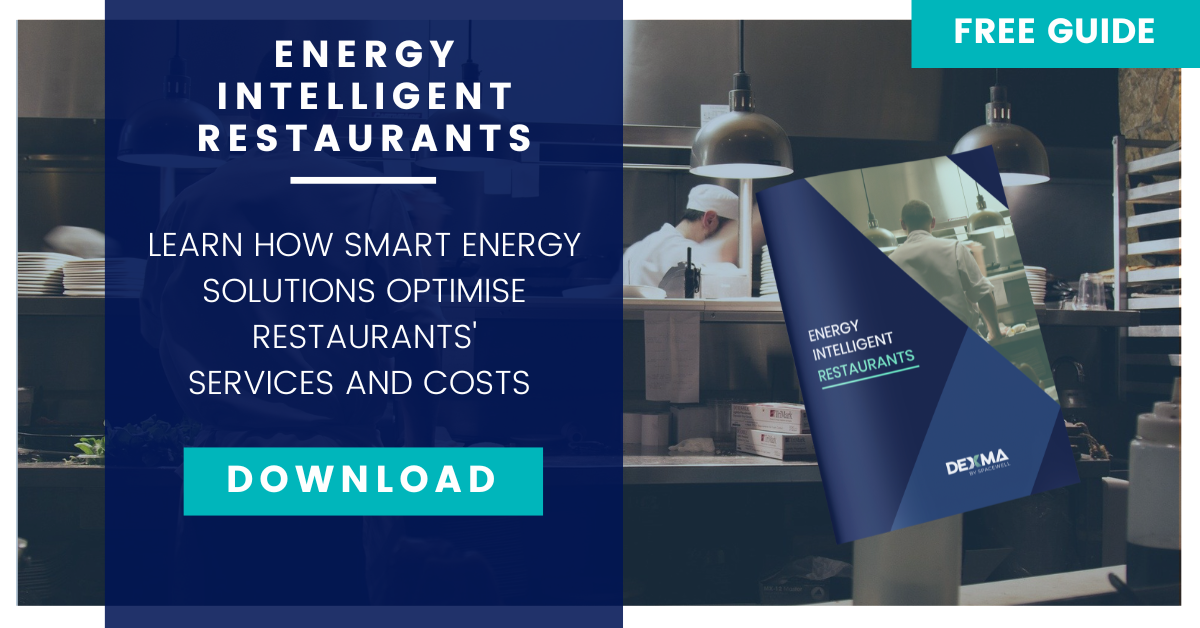Restaurants are among the most energy-intensive tertiary sector buildings in Europe, using anywhere from 3 to 10x the amount of energy used by the average commercial building, and can account for anywhere from 4-6% of operating costs according to The Carbon Trust. Finding intelligent ways to overcome these challenges while increasing the comfort of your customers is an essential way to make you their superhero, not to mention a winner with your colleagues!
The idea behind this post is to share some demonstrated examples of best practices for Smart Restaurants that can be used to transform energy waste into savings in the food service and catering sector.

Best Practices for Restaurants Investing in Smart Energy Tech
1. Paying Attention to HVAC Pays Off
HVAC systems typically account for 40% or more of a typical restaurant’s energy costs. This is a significant chunk of your budget that you could use in other areas – such as increasing margins or contributing to your sustainability objectives. To bring down those costs, it is essential to have at least a basic understanding of your building’s HVAC system energy usage if you want to leverage significant savings opportunities.
You have probably realised by this point that HVAC units are simply not designed for restaurants. Our energy manager community is constantly telling us about how even brand new HVAC units don’t cool enough in kitchens, or blow very hot or freezing cold air directly on customers.
Regular cleaning of ventilation systems can increase efficiency by as much as 50% compared with systems that are not maintained. Energy consumption can increase by up to 60% if regular maintenance is not undertaken. Dirty or faulty fans, air ducts and components directly affect system efficiency and will increase running costs and risk of breakdown.
If you air condition your kitchen, cross-drafts and misaligned appliances can allow heat and smoke to create hot, uncomfortable working conditions AND drive your energy bill through the roof! Try pushing each appliance as far back against the wall as possible to close the air gap and maximise hood overhang. Also, check the following parts of your HVAC system:
- Filters
- Belts
- Duct Connections
- Discharge Registers (Condition and Location)
- Air Damper Setting
2. Manage Hot Water More Efficiently
Hot water consumption is another major energy drain on food services facilities, from preparing food to non-stop dishwashing. Because restaurant kitchen equipment uses a great deal of hot water, reducing water usage directly is one way to help reduce water heating costs.
For equipment that requires continuous water flow, such as dishwashing equipment and food preparation sinks, upgrading components to include water distribution pipes, more efficient low-flow pre-rinse spray valves, thermal efficient faucets and other appliances with a higher Energy Factor (EF) can help make operations more efficient and cheaper as a result.
3. Don’t ignore service calls
Maintenance is expensive. Studies have shown that 75% of any building’s life cycle cost is operational – with utilities and maintenance typically the two largest cost components. Ignoring necessary service calls can result in emergency visits, disruptive shutdowns, and shorter equipment life – all of which end up costing your business.
4. Get a Virtual Energy Audit
Quick fixes like maintenance checks can only take you so far – to make meaningful savings that impact your profit margin, you will need to understand your monthly energy bill on a deeper level.
One way to do this is to bring in an energy services company (ESCO) to examine your facilities and eventually fine-tune their energy performance in person.
Their assessment followed by action could mean the difference between making a profitable year or not. But if you aren’t quite ready to pay for a full on-site energy audit yet, there is an easier, cheaper intermediate step:
DEXMA Detect is a virtual energy audit platform that not only shows if you are paying too much for your energy, but also calculates the energy savings potential of your restaurant.
By anonymously comparing the electricity consumption of your property with data from similar establishments in your area, you will immediately understand how much your facility can save.
After crunching some data from existing DEXMA Detect reports, our Product Team discovered that on average, restaurants can generate up to 30% in potential energy savings – and that’s just for electricity! (Don’t forget about gas and thermal sources – water heating is definitely among the biggest energy vampires in restaurants. More about those here.)
According to one DEXMA Detect report, a 160 m2 fast food restaurant in Spain was able to achieve an average savings of € 7,660 per year.
5. Invest Intelligently in Smart Energy Efficiency Technology
Once you are armed with your personalised savings potential data, it’s time to take the plunge into more substantial investments.
Temperature sensors for fry vats, refrigerators, and freezers ensure consistency by providing alerts when there are temperature changes that could affect product quality.
HVAC sensors maximise customer comfort at all times and anticipate equipment failures before they happen—so maintenance can be scheduled with the least disruption.
Water issues – open-close sensors have been deployed in some establishments.
Occupancy sensors compare how many people are in the restaurant with how many orders are placed.
Still, you might have questions:
- Will the lower energy, water or gas costs actually compensate for the price of new, top-of-the-line equipment?
- Can I afford a retrofit? When will it pay for itself?
If you find yourself asking these questions, it’s time to call in an energy pro to do the maths for you – but it helps to know the right questions to ask them. Plus, you’ll want to make sure that they themselves are equipped with the right tools to help you generate the energy management plan that’s right for your establishment.
To learn more about how smart energy solutions can optimise restaurant service and cost, and how to transform a traditional restaurant into a smart restaurant, you can download our white-paper below:



